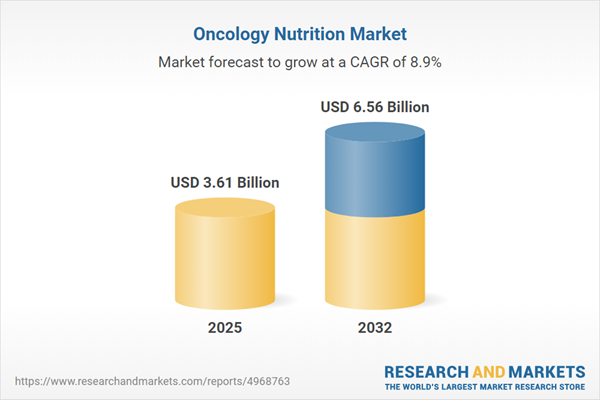Speak directly to the analyst to clarify any post sales queries you may have.
The oncology nutrition market is poised for sustained expansion, reflecting the growing emphasis on integrating tailored dietary support into comprehensive cancer care pathways. A dynamic blend of clinical innovation, digital integration, and strategic collaboration is redefining how nutritional interventions drive patient outcomes across the oncology spectrum.
Market Snapshot: Oncology Nutrition Market Size and Growth
The global oncology nutrition market grew from USD 3.32 billion in 2024 to USD 3.61 billion in 2025 and is projected to reach USD 6.56 billion by 2032, advancing at a CAGR of 8.86%. This continued growth reflects heightened demand for specialized nutrition products and evolving patient care models within oncology settings.
Scope & Segmentation
- Product Types: Enteral nutrition (elemental, modular, standard formulas), oral nutritional supplements (disease-specific, high protein, immunonutrition), and parenteral nutrition (supplemental, total parenteral nutrition)
- Routes of Administration: Enteral, oral, parenteral
- Distribution Channels: Hospital pharmacies, online retail, retail pharmacies, specialty clinics
- Geographic Coverage: Americas (United States, Canada, Mexico, Brazil, Argentina, Chile, Colombia, Peru), Europe, Middle East & Africa (United Kingdom, Germany, France, Russia, Italy, Spain, Netherlands, Sweden, Poland, Switzerland, United Arab Emirates, Saudi Arabia, Qatar, Turkey, Israel, South Africa, Nigeria, Egypt, Kenya), Asia-Pacific (China, India, Japan, Australia, South Korea, Indonesia, Thailand, Malaysia, Singapore, Taiwan)
- Company Analysis: Abbott Laboratories, Nestlé S.A., Danone S.A., Fresenius SE & Co. KGaA, Baxter International Inc., B. Braun Melsungen AG, Reckitt Benckiser Group plc, Ajinomoto Co., Inc., Koninklijke DSM N.V., Meiji Holdings Co., Ltd.
Key Takeaways for Oncology Nutrition Market Decision-Makers
- Integrating oncology nutrition as a core component of cancer therapy boosts therapy efficacy and supports patient resilience during treatment.
- Personalized nutrition solutions tailored by treatment regimens and genetic factors are becoming increasingly essential for optimizing patient recovery and quality of life.
- Digital health integration enables real-time monitoring for nutritional interventions, allowing dynamic adjustments and supporting evidence-based practices in nutrition management.
- Reimbursement frameworks are shifting towards value-based models, aligning nutritional outcomes with reduced readmission rates and streamlined care costs.
- Collaborative partnerships across manufacturers, healthcare providers, and technology leaders are accelerating product innovation and the adoption of advanced delivery methodologies.
- Regional variances underscore the importance of locally adapted strategies, as infrastructure and regulatory standards shape market adoption in the Americas, EMEA, and Asia-Pacific.
Tariff Impact: US 2025 Oncology Nutrition Import Tariffs
Forthcoming US tariffs on oncology nutrition imports in 2025 present supply chain and cost-management challenges for market participants. Manufacturers are reviewing sourcing strategies and pricing models to address rising costs, while payers and providers adjust reimbursement and procurement pathways. This market shift calls for cross-functional collaboration to ensure continued patient access and operational resilience.
Methodology & Data Sources
This report’s findings are founded on primary interviews with clinical nutrition experts, procurement leaders, and oncology specialists, supplemented by in-depth desk research including regulatory and peer-reviewed sources. Proprietary quantitative analyses track volumes and trends across institutional and retail channels, validated through triangulation and iterative peer review for accuracy and relevance.
Why This Report Matters for Senior Stakeholders
- Supports executive decision-making with actionable intelligence on current trends and innovation pipelines within oncology nutrition.
- Equips procurement and R&D leaders with segmentation insights for optimizing product portfolios and distribution strategies.
- Enables commercial strategists to anticipate market shifts influenced by regulatory, reimbursement, and tariff developments.
Conclusion
As oncology nutrition evolves into an integral part of cancer care, industry leaders that adapt to innovation, regulatory shifts, and regional market needs will be best positioned for sustained value creation. Strategic insights from this report empower forward-looking investments and collaborative strategies in a complex, competitive healthcare ecosystem.
Additional Product Information:
- Purchase of this report includes 1 year online access with quarterly updates.
- This report can be updated on request. Please contact our Customer Experience team using the Ask a Question widget on our website.
Table of Contents
3. Executive Summary
4. Market Overview
7. Cumulative Impact of Artificial Intelligence 2025
Companies Mentioned
The companies profiled in this Oncology Nutrition market report include:- Abbott Laboratories
- Nestlé S.A.
- Danone S.A.
- Fresenius SE & Co. KGaA
- Baxter International Inc.
- B. Braun Melsungen AG
- Reckitt Benckiser Group plc
- Ajinomoto Co., Inc.
- Koninklijke DSM N.V.
- Meiji Holdings Co., Ltd.
Table Information
| Report Attribute | Details |
|---|---|
| No. of Pages | 194 |
| Published | November 2025 |
| Forecast Period | 2025 - 2032 |
| Estimated Market Value ( USD | $ 3.61 Billion |
| Forecasted Market Value ( USD | $ 6.56 Billion |
| Compound Annual Growth Rate | 8.8% |
| Regions Covered | Global |
| No. of Companies Mentioned | 11 |









